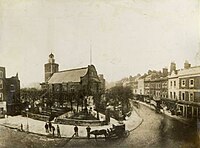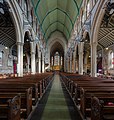St Mary Abbots
| St Mary Abbots | |
|---|---|
 St Mary Abbots Church in 2007 | |
| Religion | |
| Affiliation | Anglican |
| Ecclesiastical or organizational status | Parish church |
| Leadership | Gillian Craig (vicar) Richard Chartres (bishop) |
| Year consecrated | 1262 |
| Location | |
| Location | Kensington, London, England |
| Architecture | |
| Architect(s) | Sir George Gilbert Scott |
| Style | Neo-gothic |
| Completed | 1872 [1] |
| Specifications | |
| Capacity | 700 [2] |
| Length | 179 feet (55m)[2] |
| Width | 109 feet (34m)[2] |
| Spire(s) | One |
| Spire height | 278 feet [2] |
| Website | |
| www.stmaryabbotschurch.org | |
St Mary Abbots is a church located on Kensington High Street and the corner of Kensington Church Street in London W8.
The present church structure was built in 1872 and designed by the celebrated architect Sir George Gilbert Scott, combining neo-Gothic and early-English styles. This edifice remains noted for having the tallest spire in London and is the latest in a series on the site since the beginning of the 12th century.
History
Sir Aubrey de Vere was a Norman knight who was rewarded with the manor of Kensington, among other estates, after the successful Norman Conquest. Around 1100, his eldest son, Godfrey (great-uncle of Aubrey, 1st Earl of Oxford),[3] was taken seriously ill and cared for by Faritius, abbot of the Benedictine Abbey of St Mary at Abingdon. After a period of remission, Godfrey de Vere died in 1106 aged about 19.[2]
The de Vere family's gratitude to the abbey for their son's care was recognised by its bequest of land 270 acres (1.1 km2). In 1262 the abbey founded a church and parish in Kensington, dedicated to St Mary. The epithet of Abbots is deemed to derive from its link with the ancient Abingdon Abbey rather than that subsequently with the diocese of the Bishop of London. However, this led to a dispute with the bishop and legal action followed in the diocesan consistory court. This resulted in the patronage of the church passing to the bishop in perpetuity but rights over the surrounding land remaining with the abbey.[2] The succession of vicars is recorded in a direct line back to this foundation in 1262.
In 1370 the Norman church was rebuilt.[2]

When William III relocated the Royal Court to Kensington Palace the area became fashionable rendering the medieval church too small, thus it was demolished at the end of the 17th century and replaced by a Late Renaissance-style building. This in turn proved too small as London urbanised in the 19th century.
Around 1860 the vicar, Archdeacon William Sinclair, launched a campaign for the building of a striking new church. The architect George Gilbert Scott was engaged and recommended the demolition of the existing church to take advantage of the site at the road junction. St Mary Abbot's design is almost certainly influenced by Scott's earlier work on Dunblane Cathedral, its west front's tall window and carved tympanum, bearing similarity. The 278 ft (85 m) high spire is clearly influenced by that of St Mary Redcliffe, Bristol.[2]
The present church retains many fittings from the earlier churches, especially funeral monuments from the mid-17th century onwards.
Bells
The tower holds a ring of ten bells hung for change ringing. Five of these bells, the fourth, fifth, sixth, eighth and ninth of the current ring date from 1772 and were cast by Thomas Janaway. The other five, the treble, second, third, seventh and tenor were cast in 1879 by John Warner & Sons.[4]
Primary school
The church has an associated primary school in its churchyard, which was founded in 1707 as the Charity School.[5] Previous buildings for the school where designed by Nicholas Hawksmoor in 1711, but demolished to make way for a town hall (c. 1878). The present buildings date from 1875 and are notable for the painted stone statues of a boy and girl by Thomas Eustace (c. 1715) ,[6] now on the north face of the school; its playgrounds intersperse with the churchyard.
The school maintains close connections with the Church of England.[7][8]
Notable parishioners
- Joseph Addison
- David Cameron
- George Canning
- Michael Gove
- Thomas Macaulay
- Sir Isaac Newton (commemorated by a window in the north transept)
- Beatrix Potter
- William Thackeray
- William Wilberforce
- Diana, Princess of Wales - in 1997 it became a focus for mourners
-
West stained glass window
-
Altar and nave
-
Nave wide-angle view
-
Church entrance and cloister
References
- ^ Royal Borough of Kensington and Chelsea - Churches
- ^ a b c d e f g h Lloyd, Dr Russell (January 2004). "The Early Churches of Kensington". St Mary Abbots parish. Retrieved 2009-11-07.
- ^ www.british-history.ac.uk
- ^ "Kensington—S Mary Abbots". Dove's Guide for Church Bell Ringers. 28 August 2006.
- ^ www.british-history.ac.uk
- ^ www.rbkc.gov.uk
- ^ http://smanews.weebly.com/children.html
- ^ http://webfronter.com/rbkc/stmaryabbots/index.shtml#m-liid_259340
- Allchin, A. M. (1960). St. Mary Abbots, Kensington: a brief history and guide. Favil Press.




